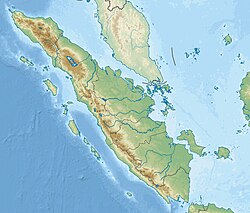| UTC time | 1907-01-04 05:19:11 |
|---|---|
| ISC event | 16957943 |
| USGS-ANSS | ComCat |
| Local date | January 4, 1907 |
| Local time | 12:19 |
| Magnitude | 7.5–8.0 Ms 8.2–8.4 Mw |
| Epicenter | 2°30′N95°30′E / 2.5°N 95.5°E |
| Fault | Sunda megathrust |
| Type | Megathrust |
| Max. intensity | EMS-98 IV (Largely observed) – EMS-98 V (Strong) |
| Tsunami | Yes |
| Casualties | 2,188 dead |
The 1907 Sumatra earthquake occurred on January 4 at 05:19:12 UTC. The re-estimated moment magnitude (Mw) is 8.2 to 8.4, [1] with an epicentre close to Simeulue, off Sumatra. [1] An earlier study re-estimated a surface-wave magnitude (Ms) of 7.5 to 8.0. [2] It triggered a widespread and damaging Indian Ocean wide tsunami that caused at least 2,188 deaths on Sumatra. [1] The low observed intensity compared to the size of the tsunami has led to its interpretation as a tsunami earthquake. Higher levels of shaking observed on Nias are attributed to a large aftershock, less than an hour later. [1] The tsunami gave rise to the S'mong legend, which is credited with saving many lives during the 2004 earthquake. [3]
